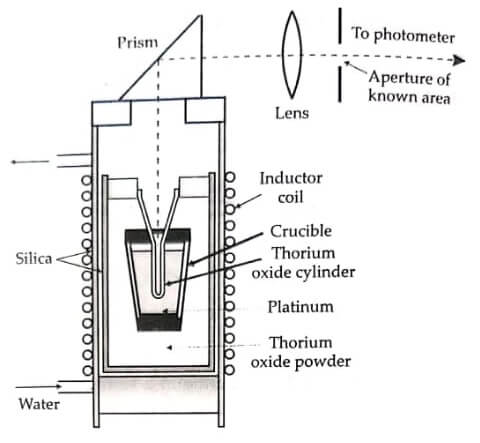The primary standard of luminous intensity in a full radiator (black body or Planckian radiator) at the temperature of solidification of platinum (2.042°k approximately) under a pressure of 101.325 kN/m². The “candela” is then defined as one sixtieth of luminous intensity per square metre of one full radiator.
Secondary standards of luminous intensity are special tungsten lamps calibrated against basic standards.
In 1948, it was decided to base the unit of luminous intensity upon the luminance (or objective brightness) of a small aperture due to light emitted from a radiator maintained at the temperature of solidification of platinum namely 2042°K. This primary standard is a full radiator at the temperature of platinum. The construction of this primary standard shown in Fig.

The radiator consists of a cylinder of fused thorium oxide about 45 mm long, with an internal diameter of about 2.5 mm. The bottom of the tube is packed with powdered fused thorium oxide. The cylinder is supported vertically in pure platinum contained in fused thorium oxide crucible. The latter has a lid with a small hole in the centre, about 1.5 mm in diameter, and is almost embedded in powdered fused thorium oxide in a larger refractory container having a funnel shaped opening.
The platinum is first melted by eddy currents induced in it by a high frequency coil surrounding the . outer container. The coil carries alternating current at a frequency of 1.6 MHz. The platinum is allowed to cool very slowly. During the period platinum is changing from liquid to solid state, the temperature remains constant sufficiently long for measurements to be made of luminous intensity of the light passing from the aperture of known diameter. The luminance of this primary standard is found to be 598,000 international candle/m² , the international candle being used prior to 1948.
In 1948 it was decided to adopt 600,000 units/m² as the luminance of primary standard. The new unit of luminous intensity was termed as “Candela”. Candela is defined as the luminous intensity, in the perpendicular direction, of a surface of 1/600,000 square metre of black body (or full radiator) at the temperature of freezing of platinum under standard atmospheric pressure.
Secondary standards of luminous intensity are special type of tungsten lamps calibrated against basic standards. The lamp power is adjusted to give an operating temperature at which the spectral power distribution of the lamp matches that of the basic standard.
- See More : Null type instruments
- See More : Deflection type instrument
- See More : Memory interfacing and I/O





